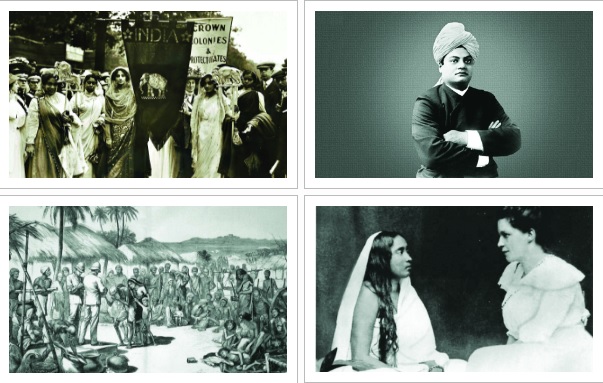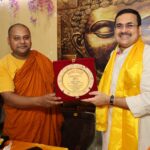Sister Nivedita & the struggle for the ‘Consciousness of Unity’
- By : Anirban Ganguly
- Category : Articles

In her later years, Nivedita’s desire to uplift her Mother India gained further momentum as she vociferously strove to further her Master’s revered legacy.
As a part of her multi-dimensional action, in the later years of her life, till 1911, Nivedita’s activities saw a prolific output in terms of talks, interviews and writings, all with the predominant objective of instilling in the youth of India a sense of their country’s greatness, exposing them to her vast civilisational repositories of knowledge, wisdom and rooting a belief in their own capacities for determining their future direction.
On a lecture tour of Nagpur in 1902, for example, she openly exhorted the youth to exercise and to meditate on developing not only intellectual but also physical strength and prowess for national uplift, ‘The country needs robust and patriotic men instead of persons who serve a foreign government and dominate over their countrymen. They alone can uplift the country.’ In her inimitable style, she told those youngsters who had gathered to listen to her that they ‘should feel disgusted to perpetuate the authoritarian rule of a foreign government by serving it.’
Her demand was for a radical overhaul of the collective attitude and mindset vis-a-vis subjection. The problem with the Indian mind, as Nivedita discerned, it was that ‘it has not reached out to conquer and possess its own land as its own inalienable share and trust, in the world as a whole. It has been content, even in things modern, to take obediently whatever was given to it…The Indian people, as a whole, for the last two generations have been as men walking in a dream, without manhood, without even commonsense.’ The only goal, therefore, worth struggling, worth the young energies, was the need to adopt an ‘aggressive policy’, the only thing that needed undivided attention was ‘The Indianising of India, the organising of our national thought, the laying out of our line of march, all this is to be done by us, not by others on our behalf.’
Autonomy of thought and of action, an entrenched conviction that the collective destiny of India was to be shaped by indigenous minds and reflect indigenous aspirations, is what was needed to further crystallise the aspiration for freedom, ‘We accept no more programmes. Henceforth, we are to become the makers of programmes. We obey no more policies. Henceforth, do we create policies…We ordain ourselves intellectually free. What then is the task before us?’
These thoughts, articulated in her opuscule, “Aggressive Hinduism”, demonstrated the level of her impatience and expressed her exhortation to Indian youth to discard passivity and to display aggression – especially intellectual – a talking back and a civilisational reclaiming. The Indianising of India could not be a piecemeal or an incrementally hesitant endeavour, ‘Aggression is to be the dominant characteristic of the India that is today in school and classroom, – aggression, and the thought and ideals of aggression. Instead of passivity, activity; for the standard of weakness, the standard of strength; in place of a steadily yielding defence, the ringing cheer of the invading host. Merely to change the attitude of the mind in this way is already to accomplish a revolution.’
Throughout her active life in India, what Nivedita primarily strove and struggled to establish was this change of the attitude of the mind. Her ceaseless interactions with young India, especially after the Swami’s passing, convinced her of the need to bring about such change; this alone could sustain the energy to keep alive the aspiration for the ultimate political and intellectual freedom.
This starkly nationalist approach, attitude and its open articulation is what attracted people to her, coupled with the aura of her being one of the chief disciples of the just-deceased Vivekananda. In those years, just after the passing of her Master, Nivedita was increasingly seen as the one carrying forward his legacy of national awakening.
It was in her early days in India that Vivekananda repeatedly spoke to her of the fundamentals of Indian civilisation and life, ‘patiently and with delicate care.’ The essence, the core of civilisational India in her many dimensions and achievements was gradually unravelled before her when Vivekananda spoke to her of ‘India’s history, philosophy, literature, the life of the common mass, social traditions, and also the lives of great personalities, both ancient and modern.’
Before Margaret, thus, was gradually drawn that ‘matchless image of eternal India, rich in her spiritual heritage, great in renunciation and tapasyā—the eternal India that lay behind the poverty-stricken, superstition-riddled, subjugated India’ that she saw around her at that time. That irrepressible urge to accept India and to plunge into her vast multitude gradually arose because of these near-daily sessions with the Swami. Vivekananda had begun moulding Margaret in a way that would enable her to face the rigours of the Indian way and to completely identify herself with its collective aspirations. She had come never to return, as she herself once candidly confessed, ‘My life is given to India. In it, I shall live and die.’
In doing this, she had completely dissolved herself, it was the Indian nationalist in her, moulded by Vivekananda, by her own gradually evolving determination to live absorbed in India, by her wide and close collaboration with a host of avant-garde nationalist thinkers of the epoch whose sole preoccupation had turned her into one of the poles of that era. ‘Her love for India,’ wrote one of her foremost biographers, Pravrajika Amtaprana, ‘was the Swami’s legacy. By a gradual and loving study of India,’ Nivedita could ‘not only understand her [India] but recognise her potentialities.’
This near-complete dissolution of herself into the vastness of India and in her destiny saw Nivedita become active in many fields and prolifically churn out cultural, educational, and political positions. Her identification with India and with her destiny and aspirations was so intense and overpowering that she wrote to Swami Brahmananda (1863-1922), during that phase when she was re-calibrating and re-directing her role, after Vivekananda’s passing, that, ‘I have identified myself with the idea of Mother India, I have become the idea itself, and I could die more easily than submit.’
This dissolution saw her encourage and support any action that symbolised the Indian national urge to break free from the yoke – both intellectual and political – of subjection. It saw her generate dynamism for an integral Swaraj – a freedom on many fronts and not just political. There has been much debate and discussion on whether Nivedita was deeply involved in the politics of Indian freedom, on whether she had received a subtle or direct sanction from her Master for her politic work and on whether all that she did was not of her own volition and construct?
My readings of Nivedita have convinced me that she was indeed an intensely political personality, a deeply politically involved, informed and articulate figure who had India’s political and cultural liberation at heart. To try and make an integral assessment of Nivedita by minimising, negating or omitting her politics will only make our assessment of hers a partial or incomplete one. As Swami Vireswaranananda (1892-1985), noted in his tribute on Nivedita’s birth centenary, ‘Her politics was of an aggressive type and she had no patience with moderate politics of the petitionary type. Therefore, the Swadeshi movement had her full support…she had realised that India had to be united if she was to achieve her freedom. It was her dream to see in India ‘the great re-establishment of Dharma, when the whole of this nation shall be united together not in a common weakness, not in a common misfortune or grievance, but in a great ever-living consciousness of the common nationality, common heritage …’

















